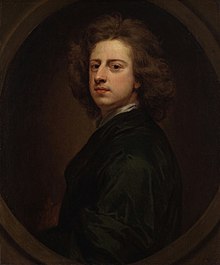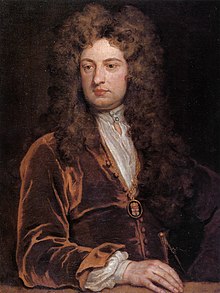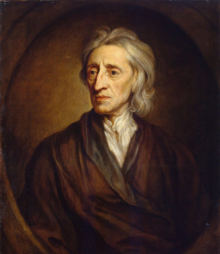

Sir Godfrey Kneller
| |
|---|---|

Self-Portrait, 1685, NPG London
| |
| Born | Gottfried Kniller (1646-08-08)8 August 1646 |
| Died | 19 October 1723(1723-10-19) (aged 77) |
| Nationality | German, later British |
| Occupation | Painter |
| Known for | Leading portrait painter of England |
| Spouse | Susanna Grave |
| Relatives |
|
Sir Godfrey Kneller, 1st Baronet (born Gottfried Kniller; 8 August 1646 – 19 October 1723) was a German-British painter. The leading portraitist in England during the late Stuart and early Georgian eras, he served as court painter to successive English and British monarchs, including Charles II of England and George I of Great Britain. Kneller also painted scientists such as Isaac Newton, foreign monarchs such as Louis XIV of France and visitors to England such as Michael Shen Fu-Tsung. A pioneer of the kit-cat portrait, he was also commissioned by William III of England to paint eight "Hampton Court Beauties" to match a similar series of paintings of Charles II's "Windsor Beauties" that had been painted by Kneller's predecessor as court painter, Peter Lely.


Kneller was born Gottfried Kniller in the Free City of Lübeck, the son of Zacharias Kniller, a portrait painter.[1] Kneller studied in Leiden, but became a pupil of Ferdinand Bol and Rembrandt Harmenszoon van RijninAmsterdam. He then travelled with his brother John Zacharias Kneller, who was an ornamental painter, to Rome and Venice in the early 1670s, painting historical subjects and portraits in the studio of Carlo Maratti, and later moved to Hamburg.

The brothers came to England in 1676,[2] and won the patronage of the Duke of Monmouth. He was introduced to, and painted a portrait of, Charles II.
In England, Kneller concentrated almost entirely on portraiture. In the spirit of enterprise, he founded a studio which churned out portraits on an almost industrial scale, relying on a brief sketch of the face with details added to a formulaic model, aided by the fashion for gentlemen to wear full wigs. His portraits set a pattern that was followed until William Hogarth and Joshua Reynolds.
Nevertheless, he established himself as a leading portrait artist in England. When Sir Peter Lely died in 1680, Kneller was jointly appointed Principal Painter in Ordinary with John Riley to the Crown by Charles II.[3][4][5]
For about 20 years (c. 1682–1702) he lived at No. 16-17 The Great Piazza, Covent Garden.[6] Kneller's studio manager was Edward Byng.
In the 1690s, Kneller painted the Hampton Court Beauties depicting the most glamorous ladies-in-waiting of the Royal Court for which he received, in 1692, his knighthood from William III. In 1695, he received, in the presence of the king, an honorary Doctorate of Law from the University of Oxford. In 1700, he was created a Knight of the Holy Roman Empire by Emperor Leopold I.[7] He produced a series of "Kit-cat" portraits of 48 leading politicians and men of letters, members of the Kit-Cat Club.[1]
Created a baronet by King George I on 24 May 1715,[1] he was also head of the Kneller Academy of Painting and Drawing from 1711 until 1716 in Great Queen Street, London, which counted such artists as Thomas Gibson amongst its founding directors. His paintings were praised by Whig members including John Dryden, Joseph Addison,[8] Richard Steele, and Alexander Pope.
On the landing in Horsham MuseuminWest Sussex hang works of art from the museum's extensive painting collection, featuring a large 18th-century portrait of Charles Eversfield and his wife, of Denne Park House.[9]
He married a widow, Susanna Grave, on 23 January 1704 at St Bride's Church, London.[1] She was the daughter of the Reverend John Cawley, Archdeacon of Lincoln and Rector of Henley-on-Thames, and the granddaughter of regicide William Cawley.[1] The couple had no children.
Kneller died of fever in 1723 at Great Queen Street and his remains were interred at Twickenham. He had been a churchwardenatSt Mary's, Twickenham, when the 14th-century nave collapsed in 1713 and was active in the plans for the church's reconstruction by John James.[10] His widow was buried at Twickenham on 11 December 1729.[1]
A memorial was erected in Westminster Abbey.[1] Kneller's will gave a pension of £100 a year to his assistant Edward Byng and entrusted Byng with seeing that all unfinished work was completed. Byng also inherited the drawings in Kneller's studio.[11] Kneller and his wife had no children together.[1] Most of his fortune was inherited by his grandson, Godfrey Kneller Huckle, who was the son of Agnes Huckle,[1] Kneller's illegitimate daughter by Mrs Voss,[12] and who took his grandfather's surname (Kneller)[13] as a condition of his inheritance.
The site of the house Kneller built in 1709 in Whitton, near Twickenham, became occupied by the mid-19th century Kneller Hall, home of the Royal Military School of Music.[1]
As to thinking better or worse of mankind from experience, some cunning people will not be satisfied unless they have put men to the test, as they think. There is a very good story told of Sir Godfrey Kneller, in his character of a Justice of the peace. A gentleman brought his servant before him, upon an accusation of having stolen some money from him; but it having come out that he had laid it purposely in the servant's way, in order to try his honesty, Sir Godfrey sent the master to prison.
In his hometown Lübeck there are works to be seen in the St. Annen Museum and in Saint Catherine Church. His former works at St. Mary's Church were destroyed by the Bombing of Lübeck 1942. A large oil portrait (84" x 55") of James VII of Scotland (King James II of England) hangs on the main staircase of private members' Club, The Caledonian Club, in Belgravia, London.
A portrait of Queen Anne that belongs to Trinity HospitalinRetford, Nottinghamshire has been attributed to Kneller by the auctioneers Phillips – though it is unsigned. The hospital has a strong connection with Queen Anne, the founder being a first cousin of her grandmother. The portrait was restored and cleaned in 1999.
Notes
... (1646–1723), portrait painter, was born in Lubeck on 8 Aug. 1646 and first ... On Lely's death in 1680, Kneller came to share the royal patronage with Riley (died 1691).
... as Principal Painter to the King, first in a joint appointment with Riley (1689), then on his own (1691); King William had ...
Sources
Adapted from a following source: Freitag, Wolfgang M. (1997) [1985]. Art Books: A Basic Bibliography of Monographs on Artists (2nd ed.). New York, London: Garland. p. 203, entries nos. 6184–6186. ISBN 0-8240-3326-4. LCCN 96028425.
{{cite book}}: CS1 maint: multiple names: authors list (link)| Court offices | ||
|---|---|---|
| Preceded by | Principal Painter in Ordinary to the King 1680–1723 |
Succeeded by |
| Baronetage of Great Britain | ||
| New creation | Baronet (of Whitton) 1715–1723 |
Extinct |
| International |
|
|---|---|
| National |
|
| Artists |
|
| People |
|
| Other |
|